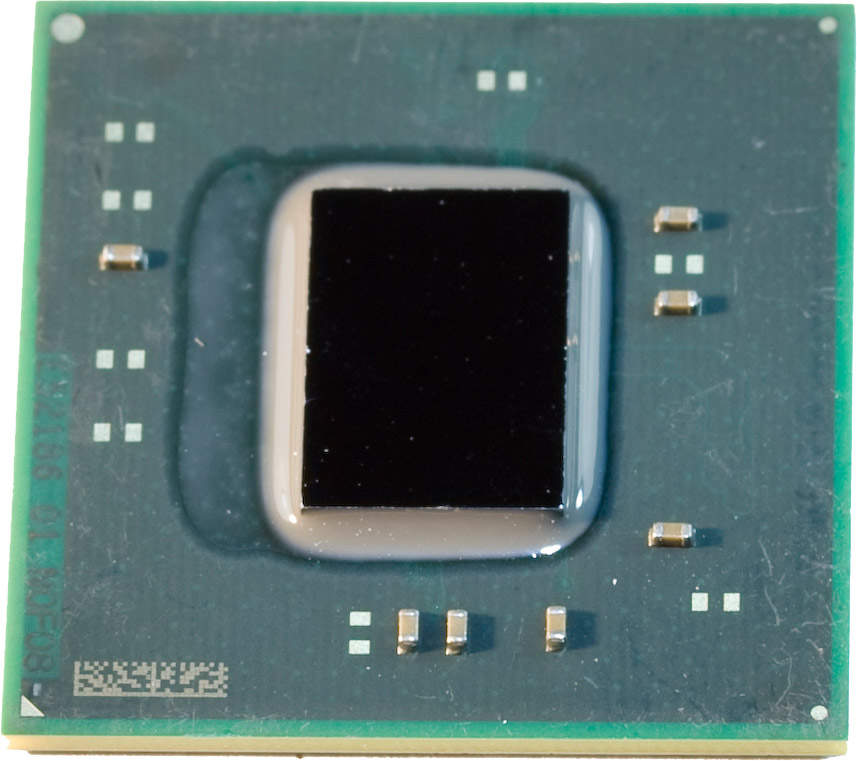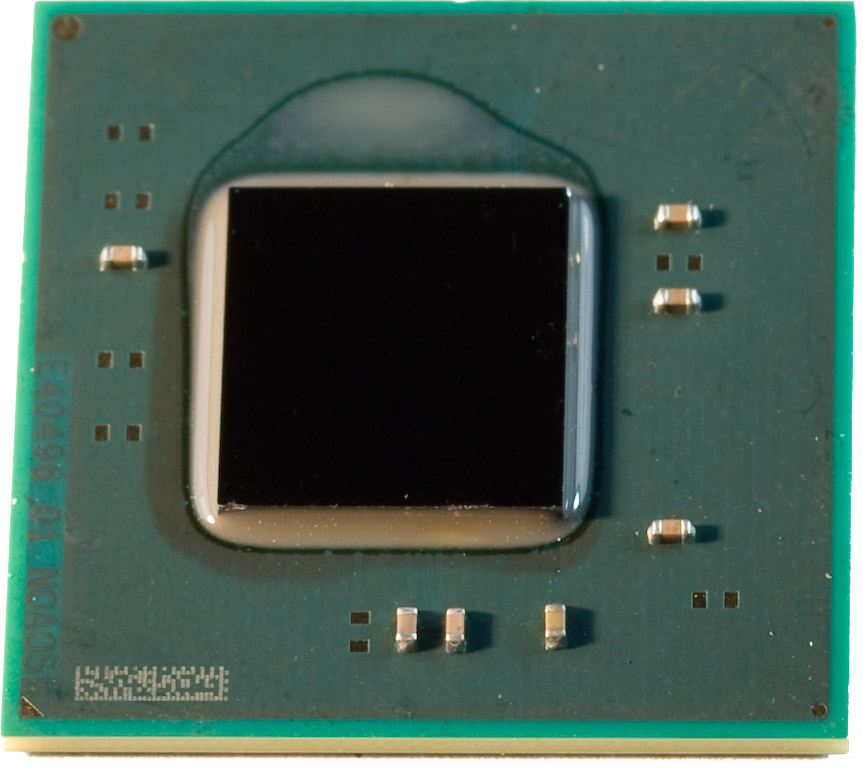Intel’s Atom D510 And NM10 Express: Down The Pine Trail With D510MO
A New Atom Lineup: Pineview Previewed
A New Atom Lineup: Pineview Previewed
So what about everything else? After all, Intel’s 945GSE came to the table with a single channel of DDR2-533 support, dual LVDS outputs, TV out, a 1 GB/s DMI connection, and support for up to a 667 MHz front side bus (in addition to the integrated GMA 950 graphics core).
As you might expect, it all migrates north into Intel’s Atom processor. The package now includes an integrated memory controller and an integrated graphics processor on a monolithic solution. But while that sounds like a massive design change, you’ll actually find that the platform’s core functionality stays the same, while ownership of certain capabilities shuffles around a bit.
What’s New
Perhaps the most highly-anticipated evolutionary change moving from the Diamondville to Pineview processor is integration of a memory controller. It’s a single-channel design, but picks up support for DDR2-800, up to two DIMMs, and 4GB of peak capacity.
The processor’s DMI interface is also wider. Whereas the 945GSE employed a two-lane connection moving up to 1 GB/s, the Atom’s on-die I/O offers four 2.5 Gb/s lanes.
| Header Cell - Column 0 | Clock Rate | # Of Cores / Threads | L2 Cache | Memory Speed Support | TDP | Market |
|---|---|---|---|---|---|---|
| Atom N450 | 1.66 GHz | 1/2 | 512KB | DDR2-667 | 5.5W | Netbook |
| Atom D510 | 1.66 GHz | 2/4 | 1MB | DDR2-800/667 | 13W | Desktop |
| Atom D410 | 1.66 GHz | 1/2 | 512KB | DDR2-800/667 | 10W | Desktop |
With entry-level Clarkdale-based Core i5 and Core i3 processors low on the horizon, the integrated graphics built into the latest Atom processors are going to be a disappointment to most folks. Intel is calling the new solution GMA 3150 and describing it as a refresh of its third-generation core. However, the specs look a lot like Intel’s GMA 950, also a third-generation derivative, or the GMA 3100 used in Intel’s desktop Bearlake chipsets. In other words, you’re getting four pixel pipelines running at 400 MHz with DirectX 9 support via software-based Vertex Shader 3.0 support and hardware Pixel Shader 2.0 support. Video acceleration is limited to MPEG-2 playback, so don’t expect a desktop based on the Atom D510 or D410 to accommodate Blu-ray movies. This actually turns out to be a bummer, because the US15W core logic already used to drive lower-power Atom-based devices includes licensed PowerVR SGX graphics able to accelerate MPEG-2, VC-1, and AVC in hardware.
Get Tom's Hardware's best news and in-depth reviews, straight to your inbox.
The integrated core offers two display outputs: one analog VGA connection at up to 2048x1536 and one LVDS channel supporting 1366x768. This is another area where Intel’s core logic trails what Nvidia offers in Ion. At least on the desktop, the ability to enable a digital display output is going to be much more attractive than VGA connectivity.
What’s Not New
As I already mentioned, much of that functionality sounds very similar to what an Atom/945GSE platform enabled before, with a few pieces moved to make the two-chip platform possible and overall power consumption to drop.
As far as the processor itself is concerned, there’s very little separating the new Atom D510 from the familiar Atom 330—with the exception of one major physical difference. Creating the 330 involved two Atom 230s on a single package, manifest as two die. The Atom D510 is a single piece of silicon. Nevertheless, it populates a micro-flip chip package that measures 22x22mm—the same size as an Atom 330.
From there, though, the internals are hard to tell apart. They’re both manufactured using Intel’s 45nm high-k metal gate silicon process. They both sport 32KB of L1 instruction cache and 24KB of L1 data cache per core, plus 512KB of eight-way L2 per core (naturally, the D410 only includes the 32/24KB of L1 and 512KB L2). And of course, both are IA-32- and Intel 64-compliant. The pair supports SSE2, SSE3, and SSSE3, are limited to C0 (operating) and C1 states.
As with the Atom 230 and 330, Hyper-Threading is a component of the Atom D410 and D510. So, a single-core processor is able to address two threads simultaneously, while a dual-core chip can work on four threads at a time.
Current page: A New Atom Lineup: Pineview Previewed
Prev Page A Big Win: No More 20W+ Platform Next Page Test Setup And Benchmarks-
It certainly is an improvement over the weak hearted Atom but I was expecting a bit more bang for the CPU's capabilities. Hopefully this will make Mini-ITX boards cheaper and more readily available for small servers and back up applications.Reply
-
scook9 My dad was looking at netbooks because he wanted something portable. What he ended up buying was the Dell Inspiron Mini 11z (not normally an inspiron fan). It has a Pentium Dual Core and the GM45 chipset (with HDMI output not VGA). This little 11" notebook gets over 6 hours of battery life and will run circles around either generation of atom processors and their chipsets/graphics. Yes the 11z did cost more than the other netbooks, but you got alot more for it, something to think about :)Reply -
matt87_50 wow, thats pretty terrible, one wonders how much better that new cpu integrated graphics is than the old chip set integrated? as basic as the ion system is, you can do anything with it, media center decoding HD, playing a couple of games, and as a file server, all with the lowest power consumption, this new one seems like its only good for the latter, and its only 3W less power.Reply
however, a file server / NAS alternative with the lowest possible power consumption is exactly what I'm after, so maybe its perfect for me, but I'd probably still go ION just because of the flexibility it offers in the future, should I get a new file server to replace it.
as for netbooks. If its a computer, I wanna be able to play games on it, and lets not forget about flash going 3D and hardware accelerated, I'd still go ION.
honestly, I wonder how they could make a GPU that crap in this day and age, the one in the iPhone and droid would be more powerful... -
little-ninja-man I just hop with this lower power usage we might see dual core atoms in netbooksReply -
liquidsnake718 I guess its not bad for beginners. I also have a netbook as my 3rd option.... I am rather enjoying the portability and functionality. As a HTCP or mini media center this sounds interesting for beginners that dont know how to build a PC... its almost plug and play..... this is a good option for them. I would prefer to get a mini-ITX board with at least a core 2 duo and build from there...... but then again, a PS2 is currently the king of this realm and you cannot compare as it has an HDMI, Great games, blu-ray, wifi, and everything one would need in this segment. Sorry the Cell is still far superior in this field!Reply -
tacoslave http://www.newegg.com/Product/Product.aspx?Item=N82E16813128342Reply
http://www.newegg.com/Product/Product.aspx?Item=N82E16819103706
quad core plus micro atx = amd win
-
djiezes Lack of HDMI, DVI or hardware accelerated decoding for MPEG4, x264 or h264 really does not make sense for a CPU/chipset that orients itself towards the desktop.Reply
Originally I thought this new chip might've made sense for htpc use. ION still beats it & ION2 is coming soon. An ordinary low powered desktop CPU for htpc use still makes more sense. AMDs Athlon X2 240E for example (45W) or maybe an Intel Pentium E3200 or alike. -
djiezes Lack of HDMI, DVI or hardware accelerated decoding for MPEG4, x264 or h264 really does not make sense for a CPU/chipset that orients itself towards the desktop.Reply
Originally I thought this new chip might've made sense for htpc use. ION still beats it & ION2 is coming soon. An ordinary low powered desktop CPU for htpc use still makes more sense. AMDs Athlon X2 240E for example (45W) or maybe an Intel Pentium E3200 or alike. -
yankeeDDL I have a question regarding the power efficiency. We see that in most tasks the Atoms are about 2X slower than the Pentium, and it seems to consume about 3~3,5X less under load.Reply
I wonder if a real/fair comparison of power consumption should be made differently.
For example: if I watch a DVD on an Atom I need, say, 100% CPU, while on a Pentium I will need only 50% of it.
So I will have the Atom burning power under full load vs 50% of the Pentium.
In other words: the Pentium is much more powerful, so it does not need to run full speed to do the same.
So, is there really an advantage in the Atom? Can you get the power/performance ratio of an Atom by simply underclocking a Pentium by few %?


